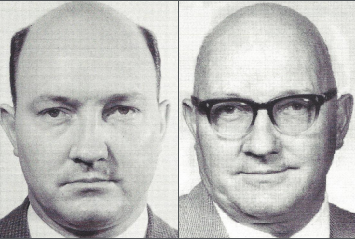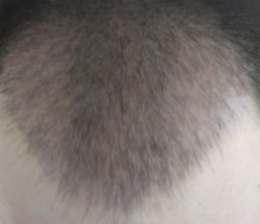A clear “cut out” patch of hair typically reflects a disease called Alopecia Areata. This is an inherited disease. You should see a dermatologist for treatment.
I have been developing hair loss in my crown after I had a frontal hair transplant 9 months ago. Why is this happening to me?
Hair loss is a progressive process, so hair loss in men is not unusual after having a hair transplant. It can accelerate the hair loss process that is destined to happen anyway. Your hair loss is unique because it appears to be in the nape of the neck, unless that area was involved in the donor area work. Go back and see your doctor and consider taking medications like Finasteride.
These photos were taken from an article published in the Hair Transplant Forum by Manny Marritt, M.D. in October 1993. Dr. Marritt died a week ago, but his ideas helped many of the caring doctors in the field of hair restoration think of the patient’s future hair loss when considering a hair transplant.
The need for a Personalized Master Plan in hair transplantation is evident in the photos below of a man who supplied pictures of himself as he aged from 16 to 62. It should be evident to all of you that this man could be you. A hair transplant that might have helped fix his receding hairline when he was 22, would look freakish when he was 35 or 62, unless there was a Master Plan to account for his advanced balding, which happens in almost 100% of balding men. Fixing this man’s hair at 22 will not help him when he is 35 or 62. I see patients every week who are caught in this conundrum – they had a hair transplant without a Personalized Master Plan.
Too many doctors, encouraged by the overly enthusiastic patient who wants to get their hair back when they are young (this could be you), do not really do them a service if they can’t see a long-term plan allowing for changes due to the progressive nature of genetic hair loss. These pictures speak for themselves. For those of you who want to know what will happen to you when you get a hair transplant, challenge the doctor who is offering you a hair transplant. With a proper explanation of what may happen to you and what will be your options if you should develop significant balding, you will have been properly educated so that you understand your future, if you continue to bald as you get older (almost a certainty). Short-term fixes at the age of 22, does little for your long-term future without a Personalized Master Plan in hand. You must know what is your donor supply with mathematical detail because unlike a bank account, you can only make withdrawals, never deposits and with poor planning, you can deplete your donor bank running out of your donor hair before you complete your balding pattern leaving you deformed from hair transplants at sometime in the future. This is almost a certainty for young men who do not approach hair transplants with a Master Plan with a good doctor.
If this man were to go to Turkey, high might get 5000 grafts at the age of 23 to fix his frontal hairline and for a year he would look great. Then in a year, he might need to address his crown so by going to Turkey he could get another 4000 grafts into his crown. Then he would be bald in the donor area plus he would have no hair to join the crown with the frontal reconstruction. He would look freaky! Solution, shave his head and get SMP for the scarring. A lot of money and time to end up with a shaved head and a tattoo.
Age: 16 22 35 62
You have a Class 4A pattern of balding with a persistent frontal forelock. The balding is behind the forelock, and the forelock looks strong. Forelocks that persist after the age of 35 often stay, and there is a strong family history in balding families with strong forelocks. For instance, a man can lose almost all of his hair and still keep his forelock. Since you reported that you are 42 years old, I think this is the case with you, but I would need to examine your forelock to see just how permanent it is and to see if there is any miniaturization in it. Weak forelocks show miniaturization, while strong ones do not. I would transplant the area around your forelock to complete the frontal hairline if your forelock is strong in addition to the area behind the forelock.
The arteries in the penis have a smaller diameter than the arteries in your heart, so it is not unusual for the first indications of atherosclerosis to appear in the penis with Erectile Dysfunction. To take the next step to find out the status of your heart, you can find a place (or speak with your doctor) and get a CT Calcium scoring of your heart. All men of your age with a standard American Diet almost certainly have atherosclerosis. This test tells you the status of your coronary arteries and what your coronary artery age is compared with others of your age. I tell people that the first sign of heart disease is death in 70% of people, but these men all have Erectile Dysfunction, which is a much earlier sign. The same is true for women if they have significant atherosclerosis. These women find that they have less sensitivity with their clitoris and less vaginal secretions when they have significant pelvic atherosclerosis. They, too, should get a CT Calcium scoring of their heart to find out if they have generalized atherosclerosis.
I’m so fearful that I made a bad decision about having a forehead lift because I, too, am losing lots of hair from the top and sides of my head. I am 7 weeks out and panic struck because I am starting took bald around the incision. It looks like I have cradle a cap that is starting to come off and the surface is raw underneath. I’m using Silvadene on it. My surgeon keeps saying that it’s all fine, but I look horrible. The suture line has not healed yet. I do have a condition called Frontal Fibrotic Alopecia. Oddly enough, the hair transplants in the area are growing!
You are fortunate that the hair is growing since this disease can impact much of the frontal hair. Hair loss is not uncommon after any facial surgery in women.
You have a terrible complication that caused you to lose a lot of your donor hair. Maybe with time, it will come back. Go back and speak with your doctor since your donor area is in trouble. You may have been donor area may have been over-harvested, or this could be shock loss since it is in the first month. If your hair comes back, you will see it return around the same time as the recipient area grafts start to grow. If the donor hair does not return, then Scalp Micropigmentation is the only solution available to you or to anyone in your situation (see: https://scalpmicropigmentation.com/).
If a heavy smoker has a hair transplant, there is potentially decreased growth because cigarette smoking reduces the blood supply to the scalp. No one can predict your results other than seeing what happens 8 months after the transplant. We are all in control of what we do.
What are your thoughts on this “new” topical Finasteride formulation which claims that, “The effectiveness appears to be equal to oral Finasteride, but serum levels are 1/18th that of the oral route.”
My problem with this is the function of Finasteride. Doesn’t Finasteride work to effectively inhibit the formation of DHT? If the serum levels of Finasteride are 1/18th, then DHT is still being formed in the rest of the body as normal, which will eventually circulate to the scalp. Do you think it’s possible that somehow this topical route actually effectively inhibits DHT in the scalp properly? Or do you think this study is not well done (it was done by the creators of the gel, so there’s obvious conflicts of interest)?
If the only prescribed strength is 2.5% gel, which is equivalent to 1.5mg orally, how would one reduce the dose of this as you mentioned in this blog post: https://newhair.com/what-dose-
I really don’t know. You want to reduce the topical dose, but I don’t know evidence that this works. Frankly, we are flying blind here.
I start college next fall, so stress is very evident in my life. Other factors: I take birth control pills, there might be some underlying black mold issues in my new apartment, and I used to take antidepressants.
You have many reasons to have hair loss. Start with your family history since it may be genetic. See a good doctor to get a proper diagnosis. The various factors you mentioned all contribute to hair loss, and for women, it is even more complex. Get out of that apartment and find another one since black mold is deadly for hair and is not good for your health.
That is a reasonable number of grafts. If you have very fine hair, then more grafts would have been better because fine hair does not have much bulk to it. However, there appears to be areas where the growth is underperforming at this time, so wait out another 2 months. If at that time the area has not filled in, go back and see your doctor.
The best donor hair is from the back and sides of the head (scalp hair). The next best spot, if the donor area is depleted, is under the chin. The chin area can yield as many as 3000 grafts in some people with heavy beard densities. I would not want to use this hair for the frontal hairline because it would be too coarse and not look natural. Beard hair taken from under the chin can’t really be seen when placed well behind the frontal hairline. Other body hair has short growth cycles, unlike beard and scalp hair which have long growth cycles, so it is not as good.
I followed your advice, “The way you find out if you have hairline recession or have a mature hairline is lift your eyebrows high so that the forehead creases. The mature hairline is found one finger breadth above the highest crease.”
When I did this, my hairline touched the highest crease. What does that mean?
That means that you still have your juvenile hair line, and you are not receding. That is good news for this point in time. The hair line in most Caucasian men becomes mature somewhere between 18-29 years of age.









